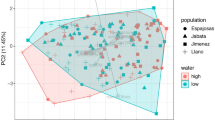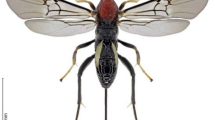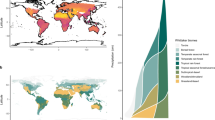Abstract
Variability in the colour of lepidopteran larvae has been recorded in a broad range of species, yet little is known of its evolutionary significance, or whether it has a genetic basis. I assess the role of genes and environment in determining the degree of larval melanization in the moth, Mamestra brassicae, and examine functional aspects of larval pigmentation. In particular, whether melanization is of importance in thermoregulation, and whether larvae differing in melanization exhibit concurrent differences in size, rate of development, and fecundity. In the fourth and fifth instars, larval M. brassicae exhibit a continuous range of colour from pale green to black: a classification scheme is described to quantify this variation. Heritability (h2) was measured using regression of brood means against mid-parent values for 36 broods (2339 offspring), and was estimated to be 0.237 ± 0.07 (SD) for fourth instar larvae and 0.421 ± 0.10 (SD) for fifth instar larvae. However, environmental factors mediated development of larval colour: larvae were darker when reared at low temperature (12°C) compared to high (24°C). Direct measurement of larval temperatures using thermocouples inserted into the alimentary canal indicated that dark larvae absorbed more radiant heat, and thus under illumination consistently maintained a higher body temperature than pale larvae. Hence dark larvae are presumed to be at a selective advantage at low ambient temperatures, and increased melanization of larvae reared at low temperatures may be adaptive. I suggest that variation within natural populations may be maintained by fluctuating weather conditions. Dark larvae were found to be smaller, but developed more quickly than light larvae so that weight at pupation, time to pupation, and fecundity (measured by the number of fertile eggs produced) did not differ according to colour. Further studies are suggested to examine the influence of larval colour on thermoregulation, growth rates and predation in the field.
Similar content being viewed by others
Article PDF
References
Brakefield, P M. 1984. The ecological genetics of quantitative characters in Maniola jurtina and other butterflies. In: Vane-Wright, R.I. and Ackery P.R. (eds) The Biology of Butterflies. Symposium of the Royal Entomological Society, vol. 11, pp. 167–190. Academic Press, London.
Burov, V, and Mokrousova, E P. 1970. On the regulating role of the population density of insects after the example of Barathra brassicae L. (Lepidoptera, Noctuidae). Entomol Obozr, 49, 257–263.
Dennis, R L H, and Shreeve, T G. 1989. Butterfly wing morphology variation in the British Isles: the influence of climate, behavioural posture and the hostplant-habitat. Biol J Linn Soc, 38, 323–348.
Dowdeswell, W H. 1981. The Life of the Meadow Brown. Heinemann Educational Books, London.
Drooz, A T. 1966. Color studies of reared elm spanworm larvae and pupae. Ann Entomol Soc Am, 59, 568–573.
Falconer, D S. 1981. Introduction to Quantitative Genetics, 2 edn. Longman, London.
Faure, J C. 1943a. Phase variation in the armyworm, Laphygma exempta (Walk.). Sci Bull Dep Agric Forest S Africa, 234, 2–17.
Faure, J C. 1943b. The phases of the lesser armyworm (Laphygma exigua (Hübn.)). Fmg in S Afr, 18, 69–78.
Fescemyer, H W, and Hammond, A M. 1986. Effect of density and plant age on color phase variation and larval development of velvetbean caterpillar, Anticarsia gemmatalis Hübner (Lepidoptera: Noctuidae). Envir Entomol, 15, 784–789.
Fields, P G, and McNeil, J N. 1988. The importance of seasonal variation in hair coloration for thermoregulation of Ctenucha virginica larvae (Lepidoptera: Arctiidae). Physiol Zool, 13, 165–175.
Hintze-Podufal, C. 1974. Untersuchungen zur Farbmusterbildung bei den Larven von Eudia pavonia L. (Lepidoptera: Saturniidae). Biol Zbl, 93, 545–559.
Hirata, S. 1954. The phase variation observed in the armyworm, Barathra brassicae L. I. The relation between the rearing density and the variation of body colour of sixth-instar larva, weight of pupa, and rate of diapause. Oyo-Dobats Zasshl, 19, 41–46.
Hirata, S. 1957a. The phase variation observed in the army-worm, Barathra brassicae L. III. Influence of larval density on body color of the fourth and fifth instar larva. Bull Educ Fac Hirosaki Univ, 3, 50–56.
Hirata, S. 1957b. The phase variation observed in the army-worm, Barathra brassicae L. IV. Some regulating mechanisms of development in crowded population. Jap J Appl Entomol Zool, 1, 204–208.
Hirata, S. 1962. On the phase variation of cabbage armyworm, Mamestra (Barathra) brassicae (L.). VI. Phase variation in larval characters under different conditions of density and temperature. Jap J Ecol, 12, 223–228.
Hodjat, S H. 1970. Effects of crowding on colour, size and larval activity of Spodoptera littoralis (Lepidoptera: Noctuidae). Entomologia exp appl, 13, 97–106.
Hovanitz, W. 1948. Differences in the field activity of two female color phases of Colias butterflies at various times of the day. Contrib Lab Vert Biol, 41, 1–37.
Hunter, F R, Crook, N E, and Entwistle, P F. 1984. Viruses as pathogens for the control of insects. In: Grainger, J.M. and Lynch, J.M. (eds) Microbiological Methods for Environmental Biotechnology, pp. 323–347. Academic Press, London.
Iwao, S. 1962. Studies on the phase variation and related phenomena in some lepidopterous insects. Mem Coll Agric Kyoto Univ, 84, 1–80.
Iwao, S. 1963. Some behavioural changes associated with phase variation in the armyworm, Leucania separata Walker. 1. Reaction of larvae to mechanical stimuli. Jap J Appl Entomol Zool, 7, 125–131.
Johnson, S J, Foil, L D, Hammond, A M, Sparks, T C, and Church, G E. 1985. Effects of environmental factors on phase variation in larval cotton leafworm, Alabama argillacea (Lepidoptera: Noctuidae). Ann Entomol Soc Am, 78, 35–41.
Jones, J S, Leith, B H, and Rawlings, P. 1977. Polymorphism in Cepaea: a problem with too many solutions? Ann Rev Ecol Syst, 8, 109–43.
Jones, D A. 1989. 50 years of studying the scarlet tiger moth. Trends Ecol Evol, 4, 298–301.
Kazimirova, M. 1992. The role of physical contact in the induction of phase polymorphism of Mamestra brassicae (Lepidoptera: Noctuidae). Acta Entomologica Bohemoslovaca, 89, 87–95.
Kettlewell, B. 1973. The Evolution of Melanism. Clarendon Press, Oxford.
Kunimi, Y, and Yamada, E. 1990. Relationship of larval phase and susceptibility of the armyworm, Pseudaletia separata Walker (Lepidoptera: Noctuidae) to a nuclear polyhedrosis virus and a granulosis virus. Appl Ent Zool, 25, 289–297.
Long, D B. 1953. Effects of population density on larvae of Lepidoptera. Trans R Ent Soc Lond, 104, 543–585.
Matthée, J J. 1945. Biochemical differences between the solitary and gregarious phases of locusts and noctuids. Bull ent Res, 36, 343–371.
Matthée, J J. 1947. Phase variation in the lawn caterpillar (Spodoptera abyssinia Guen.). J ent Soc S Afr, 10, 16–23.
Porter, T. 1983. Multivoltinism in Apanteles bignellii and the influence of weather on synchronization with its host Euphydryas aurinia. Entomologia exp appl, 34, 155–162.
Sappington, T W, Sappington, W, and Showers, W B. 1992. Lack of translation of density-induced morphological polyphenism to long-duration flight behaviour of black cutworm (Lepidoptera: Noctuidae). Ann Entomol Soc Am, 85, 188–194.
Sasakawa, M, and Yamazaki, S. 1967. Effect of population density on the larval coloration and development of larva and pupa in the larger pellucid hawk moth, Cephonodes hylas L. (Lepidoptera: Sphingidae). Jap J Appl Entomol Zool, 11, 157–163.
Saulich, A C. 1975. The group effect in the photoperiodic induction of diapause in the cabbage moth Barathra brassicae. Zool Zh, 54, 1335–1339.
Shibazaki, A, and Ito, Y. 1969. Respiratory rates of green and black larvae of the armyworm, Leucania separata (Lepidoptera: Noctuidae). Appl Ent Zool, 4, 100–101.
Smith, D A S, Shoesmith, E A, and Smith, A G. 1988. Pupal polymorphism in the butterfly Danaus chrysippus (L.) — environmental, seasonal and genetic influences. Biol J Linn Soc, 33, 17–50.
Tojo, S. 1991. Variation in phase polymorphism in the common cutworm, Spodoptera litura (Lepidoptera: Noctuidae). Appl Entomol Zool, 26, 571–578.
Watt, W B. 1968. Adaptive significance of pigment polymorphisms in Colias butterflies I. Variation in melanin pigment in relation to thermoregulation. Evolution, 22, 437–458.
Wickman, P O, and Karlsson, B. 1987. Changes in egg colour, egg weight and oviposition rate with the number of eggs laid by wild females of the small heath butterfly, Coenonympha pamphilus. Ecol Ent, 12, 109–114.
Author information
Authors and Affiliations
Rights and permissions
About this article
Cite this article
Goulson, D. Determination of larval melanization in the moth, Mamestra brassicae, and the role of melanin in thermoregulation. Heredity 73, 471–479 (1994). https://doi.org/10.1038/hdy.1994.145
Received:
Issue date:
DOI: https://doi.org/10.1038/hdy.1994.145
Keywords
This article is cited by
-
Relationship Between the Duration of Death-Feigning and Temperature in Black and Red Elytral Types of a Polymorphic Ladybug, Harmonia axyridis
Journal of Insect Behavior (2022)
-
Colors of night: climate–morphology relationships of geometrid moths along spatial gradients in southwestern China
Oecologia (2018)
-
Genetic basis of stage-specific melanism: a putative role for a cysteine sulfinic acid decarboxylase in insect pigmentation
Heredity (2012)
-
Genetic variation in developmental times among four pure lines exhibiting specific wing form and body color in the brown planthopper, Nilaparvata lugens (Hemiptera: Auchenorrhyncha)
Applied Entomology and Zoology (2011)
-
Lutein Sequestration and Furanocoumarin Metabolism in Parsnip Webworms Under Different Ultraviolet Light Regimes in the Montane West
Journal of Chemical Ecology (2006)



